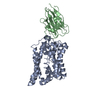+Search query
-Structure paper
| Title | Structural basis of sodium-dependent bile salt uptake into the liver. |
|---|---|
| Journal, issue, pages | Nature, Vol. 606, Issue 7916, Page 1015-1020, Year 2022 |
| Publish date | May 11, 2022 |
 Authors Authors | Kapil Goutam / Francesco S Ielasi / Els Pardon / Jan Steyaert / Nicolas Reyes /   |
| PubMed Abstract | The liver takes up bile salts from blood to generate bile, enabling absorption of lipophilic nutrients and excretion of metabolites and drugs. Human Na-taurocholate co-transporting polypeptide (NTCP) ...The liver takes up bile salts from blood to generate bile, enabling absorption of lipophilic nutrients and excretion of metabolites and drugs. Human Na-taurocholate co-transporting polypeptide (NTCP) is the main bile salt uptake system in liver. NTCP is also the cellular entry receptor of human hepatitis B and D viruses (HBV/HDV), and has emerged as an important target for antiviral drugs. However, the molecular mechanisms underlying NTCP transport and viral receptor functions remain incompletely understood. Here we present cryo-electron microscopy structures of human NTCP in complexes with nanobodies, revealing key conformations of its transport cycle. NTCP undergoes a conformational transition opening a wide transmembrane pore that serves as the transport pathway for bile salts, and exposes key determinant residues for HBV/HDV binding to the outside of the cell. A nanobody that stabilizes pore closure and inward-facing states impairs recognition of the HBV/HDV receptor-binding domain preS1, demonstrating binding selectivity of the viruses for open-to-outside over inward-facing conformations of the NTCP transport cycle. These results provide molecular insights into NTCP 'gated-pore' transport and HBV/HDV receptor recognition mechanisms, and are expected to help with development of liver disease therapies targeting NTCP. |
 External links External links |  Nature / Nature /  PubMed:35545671 / PubMed:35545671 /  PubMed Central PubMed Central |
| Methods | EM (single particle) |
| Resolution | 3.3 - 3.7 Å |
| Structure data | EMDB-13593, PDB-7pqg: EMDB-13596, PDB-7pqq: |
| Source |
|
 Keywords Keywords | MEMBRANE PROTEIN / SLC10A1 / sodium bile acid symporter / bile acid transporter |
 Movie
Movie Controller
Controller Structure viewers
Structure viewers About Yorodumi Papers
About Yorodumi Papers








 homo sapiens (human)
homo sapiens (human)